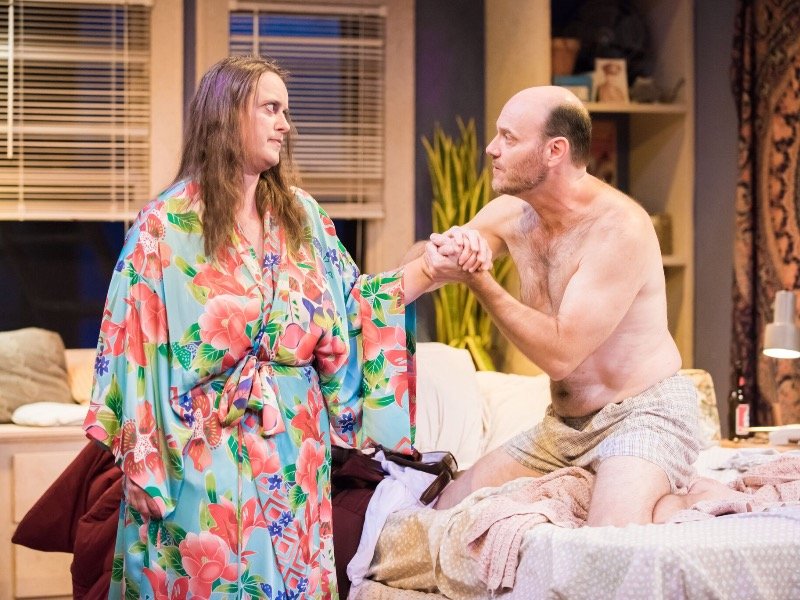For Frankie and Johnny, the sex starts out very good.
She does a thing with his ears and he does a thing with her toes and the results are very, very good, judging by the mutual shrieks, moans, panting and high-pitched squeals that rise out of the darkness in the first moments of Milwaukee Chamber Theatre’s production of Terrence McNally’s "Frankie and Johnny in the Clair de Lune." And considering it’s only their first date, and that the rhythmic waves of ecstasy are coming from on top of a hide-a-bed pulled out from an old, ugly couch in a cramped studio apartment, it seems a great end to a dinner-and-a-movie-Saturday night.
But for the two 40-somethings who’ve been flirting back and forth while working long hours at the same diner in New York City, the evening is far from over. Frankie and Johnny have both found the physical connection they were craving. Now Johnny wants something more, an emotional connection as intense as their orgasm. A life together with marriage and kids and true passion with the lights on. He’s poetic, euphoric, romantic and emphatic.
And he’s totally freaking Frankie out.
Marcella Kearns’ Frankie begins the play with firm boundaries. She’s been roughed up by romantic partners in the past, both physically and emotionally, and now she’s in charge of setting limits. Post-sex, she starts getting her life back in order, picking up clothes off the floor. Changing into a robe. Fixing herself a snack. Telling Johnny in dozens of not-so-subtle ways that he’s gotta get out of her apartment.
But Todd Denning’s Johnny simply won’t leave. Determined to the point of being creepy, he gets under her skin while he goes through her purse, her fridge, her medicine cabinet and pointed moments from her past. Desperate for a clean start after a bitter divorce and some time in jail, he wants to grab on to the happiness he sees in front of him and not let go.
He also wants to stare at her – while Frankie brushes her hair or while she reluctantly opens her robe for him to ogle her naked body. Denning, talking a-mile-a-minute about whatever random thing comes into his head, grins like he’s won the lottery.
Kearns’s eyes, meanwhile, get wider and wider with every new line of crazy conversation that Johnny launches into, envisioning a happily-ever-after that she’s given up on long ago. Her shoulders tense. Her arms cross. She puts on layers of clothes to protect herself. And then, in a moment that approaches true connection, her body melts into his, and her armor falls away. It’s a beautiful scene, allowing the entire theater to exhale.
So, as director Mary MacDonald Kerr writes in her program notes, while many plays end by answering the "will they or won’t they" question, this one starts out after the fact. Instead of figuring out how to get into each other’s pants, Frankie and Johnny try to figure out how to get into each other’s lives — and predictably, that’s a lot more complicated.
Fortunately, Kearns and Denning are up for complicated. As Frankie, Kearns displays dozens of shades of shock, hurt, fear, disdain, vulnerability, anger and annoyance simply in her transparent face. Watching her is a masterclass in subtle changes of expression that communicate more clearly than paragraphs.
As the menacing, almost maniacal Johnny, Denning is a tightly wound spring. Talking relentlessly to escape from silence, he is all pent up energy, just barely under control. Although it’s hard to find anything remotely charming about his character in the first act, a phone call to a local classical music radio station to request "the most beautiful music in the world" allows a glimpse at the gentler man underneath the nervous chatter.
Then the characters talk, posture, attack, retreat, reveal and conceal for another entire act. "Frankie and Johnny" is a talky play, a two-hander that is set in a single night and played on one set, realistically rendered by Brandon Kirkham. Unfortunately, Kerr’s direction doesn’t help the audience navigate the evening any better than the characters do. It’s an exhausting journey all around.
But over the course of their circuitous conversations, Frankie and Johnny do discover that they both began in the same place, faced many of the same miseries and ended up far from where they’d like to be. And by morning, after excavating dozens of layers of hurt and disappointment in each other, they are ready to attempt a connection much deeper – and quieter – than their initial "bumping of bodies" could ever be.







